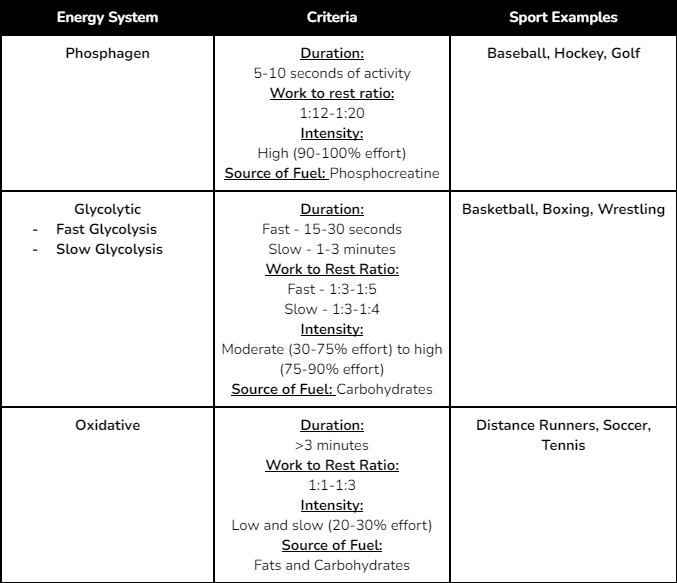Conditioning is a lot more than just running long distances or running fast. Both of those aspects are useful, but it's HOW we use them that gives an athlete their edge.
Energy is the fuel that drives our bodies during physical activity. But did you know that there are different systems that our bodies use to produce energy? To break it down, there are 3 metabolic energy systems that are “selected” as the primary system when certain work-to-rest ratios are utilized. It's important to train athletes in the energy system that they use in their sport in order for specific adaptations to take place.
The phosphagen system is the first system used when we start an activity. It provides the energy needed for short, intense bursts of activity, like a sprint or a jump. This system relies on a molecule called ATP, which stands for adenosine triphosphate. The body stores a small amount of ATP, which can be used immediately for energy. However, once the body uses up its stored ATP, it must rely on other systems to produce more.
The glycolytic system is the second system used when we start an activity. It provides energy for moderate to high intensity activities lasting up to a few minutes, like a set of weightlifting or a short-distance run. This system relies on glucose, which comes from the carbohydrates we eat. Glucose is broken down into ATP and another molecule called pyruvate. However, the downside of this system is that it produces lactic acid as a byproduct, which can cause muscle fatigue.
The oxidative system is the third system used when we start an activity. It provides energy for longer duration, low-intensity activities like a long-distance run or a bike ride. This system relies on oxygen and uses stored carbohydrates and fats to produce ATP. The upside of this system is that it does not produce lactic acid, so it can sustain activity for longer periods of time.
In summary, the phosphagen system provides energy for short bursts of intense activity, the glycolytic system provides energy for moderate to high intensity activities lasting up to a few minutes, and the oxidative system provides energy for longer duration, low-intensity activities. Understanding these energy systems can help you train more effectively and efficiently to meet your fitness goals.
Here is a cheat sheet of each energy system.

*It's important to note that all 3 systems are always working, but one may be working more than the other at a certain threshold.
*Some sports utilize a combination of all 3 energy systems consistently but may stay in 1 system more than another
Source:
Gregory, H. . G., & Travis, T. . N. (2015). Essentials of Strength Training and Conditioning 4th Edition. Human Kinetics.

Comentarios